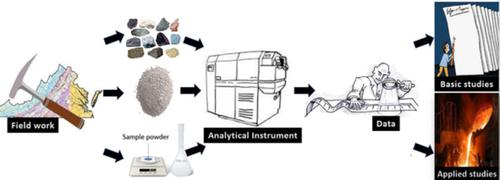当前位置:
X-MOL 学术
›
Geolog. J.
›
论文详情
Our official English website, www.x-mol.net, welcomes your
feedback! (Note: you will need to create a separate account there.)
Current and emerging analytical techniques for geochemical and geochronological studies
Geological Journal ( IF 1.4 ) Pub Date : 2020-11-02 , DOI: 10.1002/gj.4005 V. Balaram 1
Geological Journal ( IF 1.4 ) Pub Date : 2020-11-02 , DOI: 10.1002/gj.4005 V. Balaram 1
Affiliation

|
Progress in both basic and applied geochemical studies highly depend on the progress of the analytical instrumentation in general. In recent times, there have been spectacular developments in different instrumental analytical techniques used for accurate determinations of elemental/isotopic abundances from per cent levels to pg/g levels in a variety of geological materials. Some of the important instrumental analytical techniques which are currently in use for geochemical studies include atomic absorption spectrometry (AAS), inductively coupled plasma atomic emission spectrometry (ICP‐AES), recently introduced microwave plasma‐atomic emission spectroscopy (MP‐AES), X‐ray fluorescence spectrometry (XRF), instrumental neutron activation analysis (INAA), inductively coupled plasma mass spectrometry (ICP‐MS), ICP‐time of flight mass spectrometry (ICP‐TOF‐MS), high resolution inductively coupled plasma mass spectrometry (HR‐ICP‐MS), and multi‐collector‐ICP‐MS (MC‐ICP‐MS), with each one having its own merits and the limitations. Developments in sensitive high‐resolution ion microprobe (SHRIMP) opened up zircon geochronology and has revolutionized age dating of rocks by in‐situ isotopic analysis on single mineral grains such as zircons. Recently emerged MC‐ICP‐MS in combination with collision/reaction cell is allowing detection of small variations in natural isotopic compositions of non‐traditional stable isotopes. Advancements in other microanalytical techniques such as laser ablation‐ICP‐MS (LA‐ICP‐MS), electron probe micro‐analyser (EPMA), scanning electron microscopy and energy dispersive X‐ray spectroscopy (SEM‐EDS), laser‐induced breakdown spectroscopy (LIBS), have markedly improved direct solid analysis, in‐situ probing of individual minerals, fluids, and melt inclusions. Raman spectroscopy is currently emerging as a powerful geochemical analytical tool. Some interesting combination instruments such as ICP‐MS/AES showed synergic benefits when used in geochemical studies. There is also substantial progress in other critical areas such as sample preparation, sample decomposition, development of geochemical reference materials, and quality issues in general. Miniaturization is perhaps the most notable current trend in analytical techniques, and their use in exploration studies provide near‐real time sampling guidance in the field. In this review, all these aspects are updated, summarized and discussed at depth with practical examples. However, most of these instruments are expensive and complex and future developments may focus on some of the drawbacks of the current systems to realize their full potential for geochemical/geochronological studies.
中文翻译:

地球化学和地球年代研究的当前和新兴分析技术
基础和应用地球化学研究的进展在很大程度上取决于分析仪器的总体发展。近年来,用于精确确定各种地质材料中元素/同位素丰度(从百分比水平到pg / g水平)的不同仪器分析技术取得了令人瞩目的发展。当前用于地球化学研究的一些重要仪器分析技术包括原子吸收光谱法(AAS),电感耦合等离子体原子发射光谱法(ICP-AES),最近推出的微波等离子体原子发射光谱法(MP-AES),X射线荧光光谱(XRF),仪器中子活化分析(INAA),电感耦合等离子体质谱(ICP-MS),ICP飞行时间质谱仪(ICP-TOF-MS),高分辨率电感耦合等离子体质谱仪(HR-ICP-MS)和多收集器ICP-MS(MC-ICP-MS)自身的优点和局限性。敏感的高分辨率离子微探针(SHRIMP)的发展开辟了锆石年代学,并彻底改变了岩石的年龄测年法。对单一矿物颗粒(例如锆石)进行原位同位素分析。最近出现的MC‐ICP‐MS与碰撞/反应池结合使用,可以检测非传统稳定同位素的天然同位素组成中的微小变化。激光烧蚀ICP-MS(LA-ICP-MS),电子探针显微分析仪(EPMA),扫描电子显微镜和能量色散X射线光谱仪(SEM-EDS),激光诱导击穿等其他微分析技术的进步光谱法(LIBS)大大改善了原位直接固体分析探测单个矿物,流体和熔体包裹体。拉曼光谱法目前正在成为一种强大的地球化学分析工具。当用于地球化学研究时,一些有趣的组合仪器(例如ICP-MS / AES)显示出协同增效。在其他关键领域,例如样品制备,样品分解,地球化学参考材料的开发以及总体质量问题,也取得了实质性进展。小型化也许是当前分析技术中最显着的趋势,并且在勘探研究中使用它们可以为该领域提供近乎实时的采样指导。在这篇综述中,所有这些方面都通过实际示例进行了更新,总结和深入讨论。然而,
更新日期:2020-11-02
中文翻译:

地球化学和地球年代研究的当前和新兴分析技术
基础和应用地球化学研究的进展在很大程度上取决于分析仪器的总体发展。近年来,用于精确确定各种地质材料中元素/同位素丰度(从百分比水平到pg / g水平)的不同仪器分析技术取得了令人瞩目的发展。当前用于地球化学研究的一些重要仪器分析技术包括原子吸收光谱法(AAS),电感耦合等离子体原子发射光谱法(ICP-AES),最近推出的微波等离子体原子发射光谱法(MP-AES),X射线荧光光谱(XRF),仪器中子活化分析(INAA),电感耦合等离子体质谱(ICP-MS),ICP飞行时间质谱仪(ICP-TOF-MS),高分辨率电感耦合等离子体质谱仪(HR-ICP-MS)和多收集器ICP-MS(MC-ICP-MS)自身的优点和局限性。敏感的高分辨率离子微探针(SHRIMP)的发展开辟了锆石年代学,并彻底改变了岩石的年龄测年法。对单一矿物颗粒(例如锆石)进行原位同位素分析。最近出现的MC‐ICP‐MS与碰撞/反应池结合使用,可以检测非传统稳定同位素的天然同位素组成中的微小变化。激光烧蚀ICP-MS(LA-ICP-MS),电子探针显微分析仪(EPMA),扫描电子显微镜和能量色散X射线光谱仪(SEM-EDS),激光诱导击穿等其他微分析技术的进步光谱法(LIBS)大大改善了原位直接固体分析探测单个矿物,流体和熔体包裹体。拉曼光谱法目前正在成为一种强大的地球化学分析工具。当用于地球化学研究时,一些有趣的组合仪器(例如ICP-MS / AES)显示出协同增效。在其他关键领域,例如样品制备,样品分解,地球化学参考材料的开发以及总体质量问题,也取得了实质性进展。小型化也许是当前分析技术中最显着的趋势,并且在勘探研究中使用它们可以为该领域提供近乎实时的采样指导。在这篇综述中,所有这些方面都通过实际示例进行了更新,总结和深入讨论。然而,











































 京公网安备 11010802027423号
京公网安备 11010802027423号